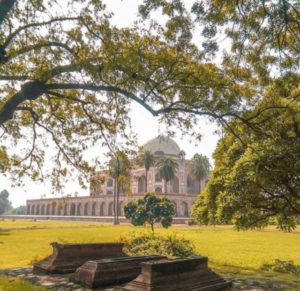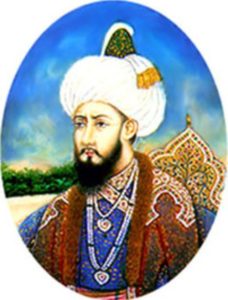Interesting Facts,History & Unique Things About Humayun’s Tomb

- By
- Aparna Patel
- |
- 3 Jan, 2020
- |

Are you looking for lesser-known facts about Humayun’s Tomb? Here is a collection of interesting and fun facts about Humayun’s Tomb which You’ve Never Heard Before.
The Mughal Emperor Humayun’s Tomb is a major tourist attraction located in the eastern Nizamuddin area between Lodhi Road and Mathura Road near the old fort. It was declared as World Heritage by UNESCO in the year 1993. This mausoleum is a very beautiful example of Mughal architecture in India.

Table of Contents
Quick Info about Humayun’s Tomb
- Location- Mathura Road, Delhi, (India)
- Other Names – Tomb-e-Humayun
- Construction period – 1565-1572
- Who built it? – Haji Begum, Architect Mirak Mirza Ghiyas and his son Syed Muhammad
- Architectural Style – Mughal Style
- Construction cost- Rs 1.5 crores
- Dimensions – 47 m (height) x 91 m (width)
- Materials Used – Red Sandstone and White Marble
- Timings – 6:00 AM to 6:00 PM all days of the week
- Status- UNESCO World Heritage Site
- Entry fee – Rs 30 for Indians and Rs 500 for foreigners
- Video camera fee – ₹ 25
- Nearest Metro Station – Jawaharlal Nehru Stadium
Interesting Facts about Humayun’s Tomb
- Humayun’s body is buried at two different places in Humayun’s Tomb.
- William Finch, an English merchant, came to see the tomb in 1611, he described in his article the inner beauty of the tomb, the canopy, the tomb and the artifacts on the walls.
- There are about 150 graves in Humayun’s tomb which is surrounded by a garden.
- Between 1903-09, a major garden restoration project started, under which sandstone was also placed in the drains.
- In 1915, the plantation was done on central and diagonal axes under plantation scheme
- At the time of the Partition of India, in August 1947, the old fort and Humayun’s Tomb were converted into refugee camps for refugees from India to newly established Pakistan. Both of these monuments were later taken over by the Indian government. These camps lasted for about five years and caused immense damage to the monuments, especially their gardens, beautiful water drains, etc.
- Its renovation work was completed by the Aga Khan Cultural Trust in March 2003. After this renovation, water flow started again in the water drains of the gardens. The capital for this work was gifted by the institution of Aga Khan IV.
- Humayun’s mausoleum was built nine years after his death.It was built between 1565 and 1572 AD on the design of the Persian architect Mīrak Mīrzā Ghiyās̄.According to a contemporary historian Abd al-Qadir Badayuni, the mausoleum was built between 1565 and 1572 AD by the architectural Persian architect Mīrak Mīrzā Ghiyās̄ (Mirza Ghiyathuddin).Mīrak Mīrzā Ghiyā was called from Herat, Bukhara (in present-day Uzbekistan) specifically for building tomb.
- Two 16-meter-high double-storey entrances are built in the west and south to enter this building.
- The tomb is 47 meters high and 300 feet wide.
- A Persian bulbous dome is also built on this tomb. This dome is built on a 42.5-meter high necked cylinder.
- On top of which a 6-meter high brass Kalash (a pitcher) is installed, which is similar to the tombs of the Timur dynasty.
- The building consists of nine square rooms including the main central chamber. The remaining 8 double-storeyed chambers surround the main chamber open in the middle.
- This mausoleum is surrounded by walls from all sides, in which beautiful gardens, small water canals, fountains, pavements and other types of attractive things can be seen.
- Humayun’s Tomb is the last resting place of the Mughal Emperor Humayun, built over 60 years before the Taj Mahal, located in the East Nizamuddin area of Delhi and the first garden-tomb in the Indian subcontinent.
- Humayun’s Tomb is a major historical and tourist destination of Delhi, which attracts a large number of history lovers. Humayun’s tomb displays the wife’s love for her dead husband.Humayun’s Tomb was included in the UNESCO World Heritage List in the year 1993 due to its magnificent design and magnificent history.
- The most important thing about Humayun’s Tomb is that it is one of the structures of that time in which red sandstone was used on such a large scale.
- This mausoleum was completely different from Humayun’s father Babur’s tomb Bagh-e-Babur, built by the Mughals.With the burial of Babur in the tomb, the tradition of burying the emperors in the mausoleums built in the garden began.Later on, other members of the Mughal royal family were also buried here.
 The place also houses the tomb of Hamida Begum (mother of Akbar), Dara Shikoh (son of Shah Jahan) and Bahadur Shah Zafar II (the last Mughal ruler). The tomb is maintained by the Archaeological Department of India. In this tomb, the depiction of Indian tradition and Parsi style of architecture is visible.
The place also houses the tomb of Hamida Begum (mother of Akbar), Dara Shikoh (son of Shah Jahan) and Bahadur Shah Zafar II (the last Mughal ruler). The tomb is maintained by the Archaeological Department of India. In this tomb, the depiction of Indian tradition and Parsi style of architecture is visible.
Who is Humayun?

Humayun was a Mughal ruler. Nasiruddin Humayun was born in 1508 AD and ascended the throne on 29 December 1530 AD at the age of 23 in Agra.Naseeruddin Humayun, son of the first Mughal emperor Babur, has contributed greatly to the foundation of the Mughal Empire. Babur had 4 sons, Humayun was the eldest. Babur appointed him as his successor.
After Babur’s death Humayun assumed the throne of India and divided the kingdom among his brothers, his cousin Kamran Mirza took the rule of Kabul and Lahore.Humayun’s rule was in Afghanistan, Pakistan, and parts of North India. In 1533, Humayun established a new city named Dinpanah.
The Battle of Chausa is one of the important battles fought in Indian history, which was fought on 26 June 1539 AD between Humayun and Sher Shah at the ‘Chausa‘ place.In the battle of Chausa, Humayun made some mistakes and lost. Humayun escaped from the war zone and somehow managed to save his life by crossing the Ganges river with the help of a recluse.
The battle of Bilgram took place between Humayun and Sher Shah, the founder of the Sur Empire. This war was fought in 1540 AD. After winning the war of Bilgram, Sher Shah forced Humayun to leave India.In 1555, he defeated Sher Shah’s officers and once again took control of Delhi Agra. He died in 1556.
Humayun’s son’s name was Jalaluddin Muhammad Akbar. At the time of Humayun’s death, his only son Akbar was in Kalanaur, Punjab. He was declared the ruler of India from Punjab.
Humayun’s Tomb History

Humayun’s tomb was built by his wife Hamida Banu Begum in his memory. Its construction work lasted for eight years (1565 to 1572). Hamida Banu Begum was the mother of the third Mughal emperor Akbar.
During the time of the Ghulam dynasty, this land was located in the Kilokari Fort, which was the capital of Sultan Qaiqabad, the son of Nasiruddin Mahmud (ruled 1246–1266).
This place was chosen for the mausoleum because there was also Hazrat Nizamuddin (dargah) on the banks of river Yamuna.Saint Nizamuddin was the famous Sufi saint of Delhi.After the death of Humayun on 20 January 1556, his body was initially buried in the old fort of Delhi. The construction of the tomb began in 1565, nine years after Humayun’s death and was completed in 1572 AD. The construction of this mausoleum was completed at that time at Rs 1.5 million which was borne by the Queen alone.
Architecture Of Humayun’s Tomb
Humayun’s tomb structure is a mixture of Islamic and Persian architecture, which is a fine specimen in red sandstone and white marble.Let me tell you that this tomb is also the first Indian structure to include the Persian double dome, which is 42.5 meters high, where the outer structure supports the exterior of the marble and leads to the inner poetic interiors.
On entering the structure through the south entrance you can see the stone meshwork. Here the body of Mughal Emperor Humayun is buried under a white dome.
Char Bagh Garden Humayun’s Tomb
Char-Bagh is a Persian style garden, with a geometric layout and is divided into 4 square walkways, hence the name Char Bagh.
In this garden, four squares are divided into small passages, making 36 squares. The garden is divided into two parts by a water body.
Tomb Other Monuments In The Complex
1.Tomb And Mosque Of Isa Khan
Isa Khan was an Afghan nobleman in the court of Sher Shah Suri. He was hostile to the Mughals and fought against them.
This octagonal mausoleum was constructed during the reign of Islam Shah Suri, the son of Sher Shah. The tomb is surrounded by an octagonal garden and later the family of Isa Khan was also buried at this place.
2.Bu Halima’s Tomb And Garden
Bu Halima’s tomb is located towards the western entrance of Humayun’s tomb. Little information is available about Bu Halima and the tomb has been added later to this place.
3.Afsarwala Tomb and Mosque
Afsarwala was an aristocrat in Akbar’s court and his mausoleum is situated towards the south-west end of Humayun’s tomb. A nearby mosque is also located in this tomb, which is believed to be dedicated to Afsarwala. These structures were built during the period 1566–67 CE.
4.Blue Dome – Nila Gumbad
Just outside the boundary of the mausoleum complex is the Nila Gumbad or “Blue Dome”, embellished with blue tiles. The most special thing about this unique structure is that it is octagonal. The Nila Dome was built by Abdul Rahim Khan-e-Khana.
5.Humayun’s Barber’s Tomb
Humayun’s Barber’s Tomb is located towards the southeast corner within the garden. Although there is no evidence of who this tomb belongs to, the locals here believe that this tomb belongs to Humayun’s Barber.
Ticket price for Humayun’s Tomb
The entry ticket for Humayun’s Tomb for Indian travelers is Rs. 35. For tourists from BIMSTEC and SAARC countries, Humayun’s Tomb ticket is also priced at Rs 35. There is no entry fee for children below 15 years.
Where is Humayun’s Tomb?
Humayun’s tomb is located in the capital city of India, New Delhi.
Best time to visit Humayun’s Tomb
Humayun’s Tomb is a famous historical and tourist destination located in Delhi. October to March is the best time to visit Delhi.
How to reach Humayun’s Tomb ?
Humayun’s tomb is located 2.8 kilometers from the Nizamuddin railway station. Taxis, buses, and auto-rickshaws are available from outside the station. This tomb is very close to Sarai Kale Khan bus depo which is located at a distance of about 8 kilometers. Autorickshaws are available outside the bus stand. The nearest metro station of this tourist destination is Jawaharlal Nehru Metro Station on Violet Line.
If you know any new things about Humayun’s tomb , then definitely tell through the comments so that other people can read,thanks.
Search Posts
Latest posts
-
4 Mar, 2024
Why are there no seat belts on trains?
-
5 Mar, 2024
Passing through airport security with autism
Popular posts
-
5 Mar, 2024
Why prohibit engine braking?
-
5 Mar, 2024
How to avoid drinking vodka?